08.08.2007
In Memory of Maxim Sorokin
Comments by GM R.Scherbakov Sorokin,M (2390) – Shirov,A (2380) D06 USSR Qualification U20, Borzhomi 1988 This game started in a rather unusual way. Both players were very creative in the opening but the complications have eventually led to the endgame, in which White had some initiative but nothing more. 1.¤f3 d5 2.d4 Ґf5 3.c4 e6 4.Јb3 4.¤c3 c6 5.Јb3 is a common option, which gives small advantage for White. 4...¤c6!? An interesting resource – Black counts on the activity of his pieces. 5.Ґg5. From the very beginning both players are trying to confuse each other! 5.Јxb7?! can be well met by 5...¤b4 6.¤a3 ¦b8 7.Јxa7 ¦a8 and Black has already got at least a draw. 5.Ґd2!? deserves attention among many other options. A possible play is 5...¦b8 6.cxd5!? exd5 (after 6...Јxd5!? 7.Јxd5 exd5 8.¤c3 ¤f6 Black gets slightly worse but playable endgame) 7.¤c3 ¤f6 8.Ґg5І with somewhat better chances according to the tournament practice. By the way, a dubious 5.¤c3? can lead to the position from the game I.Ivanov – Mezentsev/Koltanowski Memorial 2000, in which White has already faced problems after 5...¤b4! 5...¤xd4! A clever counterblow. 6.¤xd4. 6.Јa4+?! had to be answered with 6...b5! 7.¤xd4 bxa4 8.Ґxd8 ¦xd8 9.¤xf5 exf5 with advantage. 6...Јxg5 7.Јa4+ c6 8.¤c3 ¤e7 9.¦d1 g6. Perhaps 9...a6!? was more precise. 10.cxd5?! White had a rather unexpected 10.¤db5! A play would become very sharp: 10...Јf4!? 11.e4! a6!? (11...Ґg4!? 12.f3 Ґxf3 13.gxf3 Ґh6©) 12.c5! cxb5 13.Ґxb5+ ўd8 14.Ґe8 Јc7 15.0–0! Ґg7!? 16.Ґxf7 ¦f8 17.exd5 ¤xd5 18.¤xd5 exd5 19.Ґxd5 ўc8 20.c6 b5 21.Јb4© with good compensation for the piece. 10...exd5 11.¤xf5 ¤xf5. 11...Јxf5 could have led to a draw after 12.e4 Јf4 13.Ґa6!? bxa6 (13...0–0–0!? 14.Јd4 f6 15.Јxa7 bxa6 16.Јxa6+ ўd7 17.0–0©) 14.¤xd5! ¤xd5 15.Јxc6+ ўe7 16.¦xd5 (16.Јxd5 ўf6!) 16...Јxe4+ 17.ўf1 Јb1+ 18.ўe2 Јe4+ with perpetual check. 12.h4 Јf6 13.g4?! Too optimistic. Objectively stronger was 13.¤xd5 Јxb2 14.¦d2 (14.¦h3?! Ґd6 15.¦b3 Јe5 16.¦xb7 0–0 17.Јxc6 ¦ac8ѓ) 14...Јa1+ 15.¦d1 Јb2 with repetition. 13...d4?! A restrained 13...¤e7!? could have promised more chances to get advantage – White had to do a good work to prove his compensation for the sacrificed pawn. 14.¤d5! Јe5 15.Ґg2 ¤e7. In case of 15...¤g7? White seized the initiative by 16.f4! Јd6 17.¦xd4ѓ 16.f4 16.¤xe7 Ґxe7 17.Ґxc6+ ўf8 18.Ґxb7 ¦b8„ was okay for Black. 16...Јd6 17.Јxd4 ¤xd5. The only but sufficient option. 18.Јxh8 Јb4+ 19.¦d2 0–0–0 20.a3. Otherwise White is in great danger. 20...Јxd2+! After 20...Јxf4?! 21.Јd4 Јxd4 22.¦xd4 Ґg7 23.¦d3 Ґxb2 24.0–0 White's extra exchange gave him reasonable winning chances in the endgame. 21.ўxd2 Ґb4+ 22.axb4 ¦xh8 23.Ґxd5 cxd5 24.h5. The smoke has cleared. White has got some initiative in the rook ending but Black has sufficient defensive resources. 24...¦e8 25.hxg6 hxg6 26.¦h7 ¦e7 27.f5 gxf5 28.gxf5 ўc7 29.¦h6 ¦e4 30.¦f6 ¦xb4 31.ўc3 ¦b6 32.¦xf7+ ўd6! Obviously Black did not want to retreat his king to the back rank – he is fine in the forthcoming pawn ending. 33.¦f6+ ўe5 34.¦xb6 axb6 35.ўb4 ўxf5 36.ўb5 ўe4 37.ўxb6 ўe3 38.ўc5 ўxe2 39.ўxd5 ўd3 40.ўc5. Ничья. Ѕ–Ѕ Eljanov,P (2641) – Sorokin,M (2599) D24 RUS-chT, Sochi 2005 In a rare line of the QGA White's position looked promising but Black solved the problems in a tricky way. 1.d4 ¤f6 2.c4 e6 3.¤f3 d5 4.¤c3 dxc4 5.Ґg5 a6. 5...Ґb4 6.e4 c5 leads to the Vienna variation. 6.a4. 6.e4 b5 leads to the complications similar to the Botvinnik variation. The game between same opponents Eljanov – Sorokin/Moscow Aeroflot 2005 continued 7.e5 (7.a4 b4 8.¤b1 Ґb7 9.e5 h6 is fine for Black) 7...h6 8.Ґh4 g5 9.¤xg5 hxg5 10.Ґxg5 Ґe7!? (10...¤bd7!? is also worth considering) 11.Ґxf6! Ґxf6 12.Јf3! and here Black should have played 12...Ґg5! 13.Јxa8 Јxd4 14.¦d1 (14.¤e4 could be met by 14...Јxb2! 15.¦d1 Јb4+ 16.ўe2 Јb2+ 17.ўf3 Јxe5! 18.¤xg5 Јxg5 and Black gives perpetual check after 19.Јxb8 Јf5+ 20.ўe2 Јe5+=) 14...Јxe5+ 15.Ґe2 c6!› with a sharp and unclear play.; 6.e3 b5 7.a4 can be met with 7...c6!? (7...b4 is also playable: 8.¤b1 (8.¤e4 Ґb7) 8...Ґb7 9.Ґxc4 ¤bd7 10.¤bd2 Ґe7 11.¤b3 c5 and Black solves opening problems) 8.axb5 cxb5 9.¤xb5 axb5! 10.¦xa8 Ґb7© with good compensation for the exchange. Curiously enough, a very similar position might be reached in the line 5.?g5 dxc4!? in the D15 Chebanenko system/6. 6...¤c6 7.e3. In case of 7.e4 Black plays the same 7...¤a5 with a good play, for example, 8.e5 h6 9.Ґh4 g5 10.¤xg5 hxg5 11.Ґxg5 Ґe7 and so on, Shovkoplias – Yatsishin, Lvov 2001. 7...¤a5 8.¤e5 c5 9.Ґxc4. 9.Ґxf6 gxf6 10.¤xc4 cxd4 11.exd4 ¦g8 12.g3 Ґb4 was acceptable for Black in the game Schlosser – Ott, Bad Neuenahr 1989. 9...cxd4. In the game Eingorn – Gelfand, Tallinn 1989 Black preferred 9...Ґe7 10.0–0 cxd4 11.exd4 ¤xc4 (11...0–0 12.Ґd3І) 12.¤xc4 a5 13.d5! exd5 (13...¤xd5?! 14.Ґxe7 ўxe7 15.Јb3ѓ) 14.Ґxf6 Ґxf6 15.¤xd5ѓ White has seized the initiative. Yet, Black could have played 15...0–0 (15...Ґe6 16.¤xf6+ Јxf6 17.¤d6+ ўf8 was much less reliable) 16.Јf3 Ґe6 17.¦ad1 Ґxd5 18.¦xd5 Јc7І with the worse but playable position. 10.exd4 ¤xc4 11.¤xc4 a5!? Otherwise, White would advance this pawn further, then putting his knight to b6, increasing effect of the central push d4-d5. 12.Ґxf6. This idea is tempting but Black has sufficient defensive resources. 12.0–0!? Ґe7 13.d5! was probably more promising – it was considered in the notes to the move 9...cd4. 12...Јxf6. 12...gxf6?! 13.0–0 was too suspicious for Black – all his pieces were passive while his king's pawn shield damaged. 13.¤b6. 13.0–0 Ґb4 was okay for Black. It might look like Black faces troubles but he's got a rather unexpected resource. This logical move is not the best. 14...Ґb4! could have solved all the problems. White could do nothing with his knight stuck in the opponent's camp while Black simply continued his development by 0–0 and ¦f8xc8. 15.0–0 Јxc8. Black has collected the knight but it delayed his development and now White seizes initiative. 16.Јg4 g6 17.¤b5. 17.¦ac1 was met with 17...Ґh6! 17...Јd7 18.d5. In case of 18.¦ac1!? Ґd6 19.d5 0–0 20.¦fe1 ¦e8І Black kept the worse but defendable position. 18...Ґb4 19.¦ac1 0–0 20.¦fd1. An attempt to create and pressurize a pawn weakness by 20.¤c7 ¦d6 21.dxe6 fxe6 22.¤b5 let Black to activate his pieces: 22...¦d2 23.¦c7 Јd5 24.Јh3 h5 25.Јg3 Јd3! and White could face problems. 20...h5! A rather useful pawn advance. 21.Јf3. 21.Јh3 ¦c8 22.¦xc8+ Јxc8 was just fine for Black; 21.dxe6!? deserved attention but it did not bother Black very much: 21...Јxe6 22.Јf3 and here even 22...Јe5!? 23.Јxb7 ¦e6© could promise Black sufficient counterplay. 21...exd5 22.¦xd5 Јe7 23.h3 Јf6. A draw agreed. Ѕ–Ѕ Sorokin,M (2531) – Sulskis,S (2577) D25 Dubai 2002 The line Black chose against QGA does not equalise and White has maintained the advantage. Black's knight was locked on the edge of the board, he found some tricky tactics to get counterplay but one inaccurate move has led to troubles. In this game I used many of Maxim's comments, which he gave in January 2007 when showing this game to the students of Boris Spassky's chess school in my home town Satka, Chelyabinsk region. 1.¤f3 d5 2.d4 ¤f6 3.c4 dxc4 4.e3 Ґg4. This approach reminds Slav Defence and it's not very popular since Black is often forced to part with his bishop or to retreat it to the passive position. 5.Ґxc4 e6 6.h3 Ґh5 7.¤c3 Ґe7. 7...¤bd7 is known to be more accurate. 8.g4 Ґg6 9.¤e5. White clearly shows his intentions to use an awkward position of Black's bishop by h3-h4-h5. 9...¤bd7 10.¤xg6 hxg6 11.g5 11...¤h5?! This logical retreat increases Black's problems – the knight is out of play on the edge of the board. He should have opted for 11...¤d5!? 12.¤xd5 exd5 13.Ґxd5 c6 14.Ґg2 Ґxg5 (or 14...Ґb4+ 15.ўf1 Јxg5 16.Јb3 (16.d5!?) 16...Јb5+ 17.ўg1) 15.0–0 0–0 16.f4 with better chances for White but here Black did not have such bad pieces. 12.h4 c6 13.Ґd2. White's task is just to complete development and find way to open the center or the Q-side, keeping Black's knight out of play. 13...e5!? Black does not want to wait, trying to get counterplay until White takes full control over the situation. 14.d5. A tempting 14.Јb3?! was met by 14...0–0! and 15.Јxb7 exd4 16.exd4 ¦b8 17.Јxc6 ¦xb2› let Black to get active play. The knight on h5 got a chance to come into play via f4-square while the g6-pawn was untouchable: 18.Јxg6? ¤e5! 14...¤b6 15.Јe2. In case of 15.dxc6 ¤xc4 16.cxb7 Black had a strong reply 16...0–0! (16...¤xd2? 17.bxa8Ј Јxa8 18.Јa4+ ўf8 19.ўxd2ќ; 16...¤xb2?! 17.Јb1 ¦b8 18.Јxb2 Јb6±), after which White had to play 17.Јe2!, transposing to the game(while 17.bxa8Ј?! was very unreliable: 17...Јxa8 18.e4 ¦d8 19.¤d5 ¦xd5! 20.exd5 Јxd5 21.¦g1 (21.¦h3? ¤xd2 22.Јxd2 Јg2°; 21.¦h2 Јe4+ 22.Ґe3 ¤xe3 23.fxe3 Јxe3+ 24.ўf1›) 21...¤xb2ѓ with a rather annoying initiative.) 15...0–0. 15...cxd5 was met by 16.Ґxd5! 16.dxc6 ¤xc4 (16...bxc6 17.0–0–0±) 17.cxb7?! A tempting but not the best – White missed his opponent's counterstrike. He should have restrained himself to 17.Јxc4! ¦c8 18.Јd5 ¦xc6 19.Јxd8 ¦xd8 20.ўe2± with a clear advantage as Black's knight had no chances to get into play. 17...¤xe3! A very strong resource, which not so only wins one pawn back as helps Black to release his locked knight. After 17...¤xd2? 18.bxa8Ј Јxa8 19.ўxd2! Black could not get real counter chances. 18.Ґxe3 (18.bxa8Ј? Јxa8‚) 18...¦b8 19.Јb5 a6? A serious mistake. 19...Јe8! had to be played: 20.Јd5! (20.Ґxa7? Јxb5 21.¤xb5 ¦xb7 22.a4 ¦a8; 20.Јxe8?! ¦fxe8=) 20...Ґb4 (20...¤f4 21.Ґxf4 exf4 22.0–0–0±) 21.Ґxa7 ¤f4 22.Јf3 (22.Јe4? Јa4!) 22...Јb5 23.Ґxb8 ¦xb8 with compensation although after 24.¦d1І White's chances still had to be preferred. 20.Јc6! Following the main strategy – to keep Black's pieces restricted. After 20.Јxa6?! Ґb4 21.Јc6 Јe7 Black had reasonable counterplay against White's unsafe king. 20...Јe8 21.¤d5! That is the difference – White can protect his queen on c6! 21...Ґd8 22.Јxa6 Јd7 23.0–0–0 Јxb7. Forced but in the endgame White just gets decisive advantage thanks to his Q-side pawns. 24.Јxb7 ¦xb7 25.b4ќ f6 26.ўc2 fxg5 27.hxg5 ўf7 28.a4 ўe6 29.b5 Ґa5 30.ўb3 ¦f3 31.ўc4 ¤f4 32.¦h8 ¤xd5 33.¦xd5 Ґe1 34.¦e8+ ўf7 35.¦dd8 ¦h3 36.Ґc5 ¦c3+ 37.ўd5 ¦xc5+ 38.ўxc5 Ґxf2+ 39.ўd5. Black resigned. 1–0 Dziuba,M (2416) – Sorokin,M (2578) D27 Linares 2005 Here Maxim introduced an interesting idea to stop White's Q-side activity in a typical QGA endgame, solved all the problems and then outplayed his opponent. 1.d4 ¤f6 2.c4 e6 3.¤f3 d5 4.¤c3 dxc4 5.e3 a6 6.a4 c5 7.Ґxc4 ¤c6 8.0–0 Ґe7 9.dxc5. This trasposition to endgame does not promise much. However, in case of 9.Јe2 cxd4 10.¦d1 Black can also transpose to a slightly worse endgame by 10...e5!? (in the game Stefansson – Izoria/EU-ch Ohrid 2001 we considered 10...0–0 11.exd4І with a typical edge for White thanks to activity of his pieces in the position with isolated pawn) 11.exd4 exd4 12.¤xd4 ¤xd4 13.Јe5 Јd6 14.Јxd4 Јxd4 15.¦xd4І. 9...Јxd1. In case of 9...Ґxc5 White could have thought about 10.Јe2, getting the position, typical for the Furman system. 10.¦xd1 Ґxc5 11.Ґd2. White tried a huge number of possibilities and this bishop's development is rather logical. 11...b6 12.Ґd3 ¤b4. 12...Ґb7 does not equalise completely: 13.¤e4 Ґe7 (13...¤xe4?! 14.Ґxe4 f5 15.Ґd3 ўe7 16.Ґc3 ¦hg8 17.e4 ¤b4 18.exf5! ¤xd3 19.¦xd3 Ґe4 20.¦d2 Ґxf5 (20...exf5?! 21.¤g5) 21.b4 Ґd6 22.¤d4ѓ) 14.Ґc3І with a small advantage. 13.Ґe2 13...a5!? A new idea in this position – Black stops White's possible Q-side actions. By the way, we have seen a similar idea in the game Eljanov – Sorokin/RUS-chT Sochi 2005 or in the game Ponomariov – Rublevsky/Elista (m/1) 2007, when Maxim was Sergei Rublevsky's second. Both 13...0–0 14.a5 b5 15.¦ac1 Ґe7 16.¤e5, I.Sokolov – P.H.Nielsen, Malmoe 2004 and I.Sokolov – Van Wely, Villarrobledo 2006; and 13...Ґb7 14.a5 bxa5 15.¦xa5 I.Sokolov – Wells, London/Crowthorne 2006 let White to maintain small advantage. 14.¤b5 ўe7 15.¤fd4. Perhaps White should have activated his bishop first: 15.Ґc3!? Ґb7 16.Ґe5 ¦hd8 17.¤fd4 with a slight edge. 15...Ґb7 16.f3. 16.¤b3 ¤e4 was fine for Black. 16...¦hd8 17.ўf1 e5. 17...¤c6!? 18.¤b3 Ґb4 was also good enough. 18.¤f5+ ўf8 19.e4 ¤e8 20.Ґe3 ¤a6. Black keeps everything under control. 21.Ґxc5+. It deserved attention to place the light-squared bishop more actively: 21.Ґc4!? ¦ac8 22.b3 and so on. 21...¤xc5 22.¤e3 ¦xd1+ 23.Ґxd1 Ґc6 24.¤c4. After 24.¤a3 f6 25.¤ac4 ¦b8 the position was just equal but the game continuation is also not dangerous for Black. 24...Ґxb5 25.axb5 ¤d7 26.b4 Or 26.Ґe2 ¦d8 26...¦c8! 27.¤xb6! An interesting sacrifice. White gets powerful passed pawns but Black has sufficient resources. 27.Ґe2 axb4 28.¦b1 ўe7 29.¦xb4 ¤d6 was fine for Black. 27...¤xb6 28.bxa5 ¦a8 29.Ґb3 ¤d6 30.¦a2 ¤d7 31.Ґd5 ¦a7 32.b6 ¦a6 33.b7?! Too ambitious – White should have been more accurate, playing against superior forces. After 33.ўe2 ўe7 (or 33...¤c5 34.¦c2 ¦xa5 35.b7 ¤cxb7 36.Ґxb7 ¤xb7 37.¦c8+ ўe7 38.¦c7+=) 34.ўd3 ¤c5+ 35.ўc3 ўd7 36.ўb4 ¤d3+ 37.ўc3 ¤c5 38.ўb4= the game would have ended with repetition of moves. 33...ўe7 34.f4 f6 35.¦b2 ¤b8. Black could have also get advantage by 35...exf4! 36.b8Ј ¤xb8 37.¦xb8 ¦xa5 38.¦g8 f5! 39.¦xg7+ ўf6 40.¦xh7 fxe4µ but he did not want to give up his extra piece so easily. Yet, it was probably more promising way. 36.¦c2 ўd8 37.fxe5 fxe5 38.Ґe6! ¦c6 39.a6! ¤b5 40.¦xc6 ¤xc6 41.Ґc4 ¤ba7. Finally Black managed to take White's passers under control but his knights are too passive. 42.ўf2 ўc7 43.ўg3 ўb6 44.ўg4 ўc5!? After 44...¤b8 45.ўf5 ¤ac6 46.h4 ¤xa6 47.Ґxa6 ўxa6 48.b8Ј! ¤xb8 49.ўxe5 Black couldn't keep his pawns alive. 45.Ґd5?! A small inaccuracy. It seems that White could hold the position by 45.Ґf1 ¤b8 46.ўf5 ¤ac6 47.ўe6; or 45.Ґg8 h6 46.ўf5 ўb5 47.ўg6 ўxa6 48.g4 ўxb7 49.ўxg7 and it is hard to believe Black would play such position for a win. 45...¤b8 46.ўf5 ўd4! 47.ўe6? This is already a serious, maybe fatal mistake. White should have played 47.Ґg8 h5 48.h4 ¤xa6 49.ўg6, collecting both Black's pawns and getting connected passers. 47...¤xa6 48.ўf7 g5 49.ўf6 g4 50.ўg5 g3! The point – Black breaks opponent's pawn structure. 51.hxg3 ¤b5 52.Ґg8 Or 52.ўh6 ¤d6 52...¤d6 53.Ґxh7 ¤xb7 54.ўh4 ¤ac5 55.g4 ¤d6 56.g5 ¤dxe4 57.g4 ¤e6 58.g6 ¤g7 59.Ґg8 ўe3 60.Ґc4 ўf4 61.Ґd3 ¤g5 62.Ґc2 ¤f3+ 63.ўh3 ¤e1. Black could collect both White's pawns easily by, for example, 63...ўg5 64.ўg3 ¤h4 but in fact he should keeps White's pawns on the board as two knights cannot mate opponent's king on empty board. 64.Ґb1 ўe3 65.ўh4 ўf4 66.ўh3 ¤f3 67.Ґc2 ¤g5+ 68.ўh4 e4 69.Ґxe4 ¤xe4 The position is winning for Black. His task is to lock White's king in the corner with king and knight and then another knight comes to give mate. Here it's not so difficult as opponent's king is already cornered. 70.g5. Or 70.ўh3 ўf3 71.ўh2 ўf2 72.ўh3 ¤g5+ 73.ўh4 ¤5e6 74.g5 ўf3 and so on. 70...ўf3 71.ўh3 ¤g3 72.ўh2 ¤3f5 73.ўh3 ¤e7 74.ўh2 ¤xg6. This pawn can be taken. White can survive if he has far advanced pawn but his g5-passer does not bother Black much. 75.ўg1 ўe2 76.ўg2 ¤h5 77.ўh3 ўf3 78.ўh2 ¤hf4 79.ўg1 ўe2 80.ўh2 ўf2 81.ўh1 ¤e5. White resigned. 81...¤e5 82.g6 ¤g4 (82...¤f3?? 83.g7 ¤e2 84.g8Ј) 83.g7 ¤e2 84.g8Ј ¤g3#. 0–1 Epishin,V (2550) – Sorokin,M (2455) D30 URS-ch U26, Minsk 1990 A transposition from Slav Defence to some kind of Catalan may promise advantage for White. Black has some options but approach, which Maxim Sorokin used to play is one of the most promising. A quick development of his Q-side pieces helps Black to stop a typical e2-e4 advance just in time and achieve a good play. 1.d4 d5 2.c4 e6 3.¤f3 c6 4.Јc2 ¤f6 5.¤bd2 ¤bd7 6.g3 Such order of moves gives White a chance to play the line 6.e4!? dxe4 7.¤xe4 ¤xe4 8.Јxe4 Ґb4+ 9.Ґd2 Ґxd2+ 10.¤xd2, which gives him some edge. 6...b6!? A very interesting approach – Black develops his Q-side first of all. Maxim introduced this idea to his friends many years ago and it served very well. 7.Ґg2 Ґb7 8.0–0 c5! Just in time preventing the planned e2-e4! The tournament practice gives White better chances after 8...Ґe7 9.e4І. 9.cxd5. Other options also seem harmless for black, for example: 9.dxc5 Ґxc5 10.cxd5 ¤xd5 11.¤e4 Ґe7 12.Ґg5 0–0, Staniszewski – Scherbakov, Polanica Zdroj 1996; or 9.¦d1 ¦c8 10.b3 dxc4 11.Јxc4 Ґe7, Davies – Sakaev, Gausdal 1992 – in both cases Black had no problems. 9...¤xd5 10.¤b3. Once I played this position and after 10.dxc5 produced 10...bxc5? after 50 minutes of thinking! To my excuse I can say that I just came to play this European Club match from the very tough round-robin tournament and was totally exhausted. I remembered Maxim adviced to capture with the pawn and our analysis proved that Black should be fine but here I just could not find the point of it – quite understandable since I just mixed different positions. Nevertheless, I trusted Maxim... to the pleasure of my opponent, who could not believe his eyes. The game Krasenkow – Scherbakov, EuroCup (m/1) Moscow 1991 continued 11.¤c4 Ґe7 12.¦d1 0–0 13.a3, and White has got a comfortable edge and convincingly converted it to a full point. By the way, on the next day in a second leg of our match one strange thing more happened. At one point Krasenkow resigned. I was certainly happy but could not completely understand why he did it in the worse but playable position. In fact I was already winning a whole piece... 10.e4 can be well met with 10...¤b4 with reasonable counter chances, Magerramov – Sorokin, Chelyabinsk 1991 – that was the tournament I came from to play the above-mentioned game. 10.Јa4 a6 11.¤e4 b5 was acceptable for Black in the game Christiansen – Topalov, Las Palmas 1993 as well as 10.a3 ¦c8 11.e4 cxd4 12.Јa4 ¤5f6, Andersson – Atalik, Tallinn 1998 – here after 13.Јxa7? ¤c5 14.e5? ¤d5 15.b4 ¦a8 White has lost his queen. 10...Ґe7. 10...¦c8!? deserves attention as well: 11.dxc5 ¤xc5 12.Ґg5 Ґe7 13.Ґxe7 Јxe7 with a good play, Mastrovasilis – Haba, Mallorca 2004. 11.Ґd2. In case of 11.dxc5 Black could think about 11...¦c8!? 11...¦c8 12.dxc5 ¤xc5. As far as I remember we actually considered 12...bxc5!? here – with White's knight on b3 the pawn's capture has much more sense. 13.¤xc5 Ґxc5 14.Јa4+ Јd7. 14...Ґc6!? might have been stronger. 15.Јxd7+ ўxd7 16.¤e5+ ўe7 17.¤d3 Ґa6! After this strong move it is already White who has to be careful. 18.¤xc5 ¦xc5 19.¦fc1 ¦hc8. The pawn was untouchable: 19...Ґxe2?? 20.¦xc5 bxc5 21.Ґxd5 exd5 22.¦e1ќ. 20.¦xc5 ¦xc5 21.Ґxd5. White is careful – a draw agreed. Ѕ–Ѕ Crouch,C (2415) – Sorokin,M (2570) D31 Katowice 1992 A theory of the Slav Gambit was not well-developed in the pre-computer era and White sometimes refused to sacrifice a pawn – however, it couldn't promise real advantage. In this game Black comfortably equalised and then convincingly outplayed his opponent in the endgame. 1.d4 d5 2.c4 e6 3.¤c3 c6 4.e4 dxe4 5.¤xe4 Ґb4+ 6.¤c3. This retreat is harmless for Black. 6...c5 7.¤f3. White tried some other options but they are either harmless for Black or lead to the other lines. For example, 7.Ґe3 ¤f6; 7.a3 Ґa5!?; or 7.d5 ¤f6. 7...¤f6 8.Ґe2. Here also such continuations as 8.a3 Ґa5!? 9.Ґe3 ¤c6 10.dxc5 Ґxc3+ (or 10...Јxd1+ 11.¦xd1 ¤e4 12.¦c1 ¤xc3 13.bxc3 e5 with good play for Black, Lerner – Lukacs, Polanica Zdroj 1986) 11.bxc3 Јa5!? Z.Polgar – Portisch, Budapest 1993; or 8.Ґe3 cxd4!? 9.¤xd4 Ґxc3+ 10.bxc3 0–0 11.Ґe2 Јe7 Seirawan – Ribli, Barcelona 1989 do not bother Black very much. 8...¤c6 9.a3. 9.dxc5?! leads to Black's advantage after 9...Јxd1+ 10.Ґxd1 ¤e4 11.0–0 ¤xc3 12.bxc3 Ґxc5 Kirillov – Sokolsky, Vilnius 1949. 9...Ґa5! Black can leave the pawn on c5 unprotected. 10.dxc5. In case of 10.Ґe3 ¤e4 (10...¤g4!?) 11.¦c1 ¤xc3 12.bxc3 cxd4 13.¤xd4 ¤xd4 14.Ґxd4 0–0 15.0–0 Black is okay, Grigorian – Karasev, Chelyabinsk 1972. 10...Јxd1+ 11.Ґxd1. 11.ўxd1 Ґxc3 12.bxc3 e5 is fine for Black. 11...¤e4 12.Ґd2 Ґxc3 13.Ґxc3. 13.bxc3!? deserved attention: 13...¤xc5 (after 13...¤xd2 14.¤xd2 ўe7 15.¦b1 White can create pressure over Black's Q-side) 14.Ґe3 ¤d3+ 15.ўd2 ¤de5 (15...¤b2 16.Ґe2 ¤a5?! 17.¤e5! f6 18.¦ab1±) 16.¤xe5 ¤xe5 17.Ґe2 Ґd7 with good play for Black but White is also okay. 13...¤xc3 14.bxc3 Ґd7!? In the game M.Gurevich – Khenkin, Polanica Zdroj 1999 Black preferred 14...¤a5 15.¦b1!? ўe7 (15...¤xc4 16.Ґe2 ¤a5 17.¤d4ѓ) and here White could have achieved some edge by 16.¤e5! (16.¦b5?! ¤xc4 17.Ґe2 a6 was fine for Black) 16...f6 17.¦b5! and if 17...¤c6 then 18.¤xc6+ bxc6 19.¦b4 and White's tripled Q-side pawns are rather useful. 15.¦b1 0–0–0 16.¤g5 ¤e5 17.¤e4. 17.Ґe2!? could be well met with 17...Ґc6 18.f4 h6! 19.fxe5 hxg5 20.0–0 ¦d7 with roughly equal play but perhaps White should have still played this. 17...Ґc6 18.¤d6+ ўc7. White's invasion does not bring him anything substantial while his poor pawn structure might eventually tell. 19.0–0 ¦hf8 20.Ґf3 ¤xf3+ 21.gxf3 21...a6?! Perhaps Black was a bit relaxed, enjoying control over the position. There was nothing wrong with 21...Ґxf3 22.¤b5+ ўb8 23.¤d4 Ґe4 24.¦b2 e5 25.¤b5 Ґf3µ with a clear advantage. 22.¦fd1?! White returns the favour. He should have protected the pawn by 22.ўg2!? with reasonable chances to hold on after 22...g5 23.ўg3 f5 24.¦fe1 and so on. 22...Ґxf3 23.¦d2 ¦d7 24.¦b6 Ґc6. Now Black's advantage is beyond doubts – White has nothing to do and can only keep waiting. 25.f4 ¦fd8!? 25...g5!? 26.fxg5 ¦g8 was also promising. 26.¦db2 ¦xd6 27.cxd6+ ¦xd6 28.¦6b3 ¦d1+ 29.ўf2 ¦d3 30.ўe1 a5 31.a4 ¦h3 32.¦d2 ¦h5 33.¦a3 ўb6! 34.¦aa2 ўc5 35.¦d4 ¦h3. Step by step Black improved his position – White is facing inevitable material losses as his pawns are too vulnerable. 36.¦d8 ўxc4 37.¦f8 f5 38.¦f7 g6 39.¦e2 ўxc3 40.¦xe6 ¦xh2 41.¦ee7 ¦h4 42.¦xh7 ¦xf4 43.¦hg7 ¦xa4. 5 pawns have been collected during 8 moves! 44.¦xg6 ¦e4+ 45.¦xe4 Ґxe4. White resigned. 0–1 Maksimenko,A – Sorokin,M (2425) D31 URS-chT U18, Kramatorsk 1989 This game has been played in one of the crucial matches between Russia and Ukraine at the Soviet Union junior team Championship. Maxim surprised his opponent with a rare continuation in a deep line of the Slav Gambit and scored a very important win with black pieces. 1.d4 d5 2.c4 c6 3.¤c3 e6 4.e4 dxe4 5.¤xe4 Ґb4+ 6.Ґd2 Јxd4 7.Ґxb4 Јxe4+ 8.Ґe2 ¤a6 9.Ґd6 b6 10.¤f3 Ґb7 11.¤e5 f6 12.0–0 fxe5 13.Ґh5+ g6 14.¦e1 14...Јxc4!? It has been known since the 50's that 14...Јh4 is enough to equalise and despite some efforts, White could not alter this assessment. The main line is 15.Ґg4 ¦d8 16.¦xe5 ¤c5! (16...¤c7? 17.Ґxe6 ¤e7 18.Ґxc7 ¦xd1+ 19.¦xd1‚) 17.b4 ¤h6 18.bxc5 Јxg4 and recently White tried to get winning chances by 19.f3!? (he can also force a draw by playing 19.Јxg4 ¤xg4 20.¦xe6+ ўd7 21.¦e7+ ўc8 22.¦ae1 bxc5 23.¦c7+ ўb8 24.¦b1 ¦xd6 25.¦bxb7+= with perpetual check) 19...Јh4 20.¦xe6+ ўf7 21.g3 Јg5 22.Јe2 (22.f4? Јxc5+!) 22...¦d7 23.¦e1 ¤f5 24.¦e8 ¤d4 25.Јe4 Јf6 26.¦e7+ ¦xe7 27.Јxe7+ Јxe7 28.¦xe7+ ўf6 29.¦xb7 ¤xf3+ 30.ўg2 ¤e5 31.cxb6 axb6 32.¦xb6 ¤xc4 33.¦xc6 ¤xd6 34.¦xd6+ The initiative brought White an extra pawn but the ending is obviously drawn, Buturin – Borovikov, Dnepropetrovsk 1993. 15.¦xe5?! 15.Ґe2 is harmless for Black: 15...Јd5 16.Јxd5 cxd5 17.Ґxa6 Ґxa6 18.Ґxe5 ¤f6 19.Ґxf6 0–0 20.¦xe6 ¦ae8 with drawn ending, for example, 21.¦d6 ¦e2 22.h4 Ґc8 23.Ґd4 ¦e4 24.¦xd5 ¦xh4 25.¦c1 ¦hf4 26.¦c7 with a draw, Doric – J.Geller, Pardubice 2005. 15.Ґxe5 is the strongest reply, which occurred in the game Akhmadullin – Arzumanyan/corr. 1991: 15...¤f6 16.Ґxf6 0–0 17.Ґc3 c5 18.Ґg4 Ґd5 with unclear play. 15...0–0–0 16.Ґe2. 16.Ґg4 could be well met with 16...¤c5 17.Ґh3 ¤f6 18.b4!? Јc3! 19.¦e1 ¦xd6 20.Јxd6 ¦d8 21.Ґxe6+ ¤xe6 22.Јxe6+ ўb8µ with a clear advantage. 16...Јh4 17.g3? 17.¦xe6 should have been played although Black was already better after 17...¤h6! (17...¤c7 18.g3 Јg5 19.Ґg4 ўb8 20.h4 Јd5 21.Јxd5 cxd5 22.Ґe5 ¤h6 23.Ґh3 was okay for White) 18.Ґxa6 Ґxa6 19.¦c1 Ґb5 20.Јf3 ¦xd6 21.¦xd6 Јe7 and so on. 17...Јf6! White certainly underestimated this move. 18.¦xe6 Јxe6! 19.Ґg4 ¦xd6! 20.Јxd6. After 20.Ґxe6+ ¦xe6 Black gained too many pieces for the queen but the game continuation does not give White any chances to survive. 20...Јxg4 21.Јf8+ ўd7 22.¦e1. Or 22.Јg7+ ¤e7 23.Јxh8 c5 etc. 22...Јd4 23.Јe8+ ўc7 24.Јf7+ Јd7 25.Јf4+ Јd6 26.Јf7+ ¤e7. Black gets his rook into play, securing decisive material advantage so White resigned. 26...¤e7 27.¦xe7+ ўc8 28.¦xb7 ¦f8 etc. 0–1 By the way, that day is also a nice memory for me since I also managed to score and also with black pieces. Other games have been drawn and so we have won the match with a decent score – this victory has almost secured an overall win in the competition. Khomyakov,V (2380) – Sorokin,M (2570) D31 Katowice 1992 Maxim Sorokin's efforts increased popularity of the Noteboom variation. Here a tempting White's move turned out to be a serious mistake, which is well-known nowadays but to prove that Black had to sacrifice one of his K-side pawns with check, gaining huge positional pluses on the other side of the board. 1.d4 d5 2.c4 e6 3.¤f3 c6 4.¤c3 dxc4 5.e3 b5 6.a4 Ґb4 7.Ґd2 a5 8.axb5 Ґxc3 9.Ґxc3 cxb5 10.b3 Ґb7 11.bxc4 b4 12.Ґb2 ¤f6 13.Ґd3 ¤bd7 14.Јc2 Јc7 15.0–0 0–0 16.¤e5? This move looks tempting but actually, it is a serious mistake. 16...¤xe5! This rather unexpected capture, which is well-known nowadays, gives better chances for Black. 17.dxe5 ¤d7 18.Ґxh7+ ўh8. Black sacrificed the pawn but now White's strong central pawns are harmless while Black's Q-side passers are ready to go with support of the powerful knight on c5. 19.Ґe4. White has also tried other options but in any case Black's play is rather simple – first of all the knight goes to c5, supporting the pawns, then he should take care about his king... 19...a4!? A small trick helps Black to advance the pawn without knight's support. 19...Ґxe4 20.Јxe4 ¤c5µ was also good. 20.Ґxb7 Јxb7 21.¦ad1?! This attempt to bother Black's king fails but White already needed a good advice. I also played this position once, the game Shneider – Scherbakov, Moscow INTEL (rapid) 1994 continued 21.f4 a3 22.Ґd4 b3 23.¦fb1 bxc2 24.¦xb7 ¦fb8, and here my opponent resigned. In addition to the lost position he was probably disappointed with a fact he had only 2 minutes left while I only spent 2 minutes out of 25. By the way, the pawn on a4 was untouchable: 21.¦xa4?? b3°; 21.¦fb1!? seemed to be the best chance to survive. 21...a3 22.¦d4 g6 23.Ґa1 b3 24.Јd3 ¤c5 25.¦h4+ ўg7 26.Јd4 26...¦h8! The simplest. 27.¦xh8 ўxh8 28.Јxc5 b2 29.Јb5 Or 29.Ґxb2 axb2 30.¦b1 ¦a1° 29...Јxb5 30.cxb5 ¦c8. The pawns are unstoppable – White resigned. 0–1 Sorokin,M (2490) – Landa,K (2445) E07 RUS (zt), St Petersburg 1993 With white pieces Maxim often played slow, not too ambitious openings but his opponents never felt themselves comfortable. He could skilfully maintain a small advantage but when given a chance he could finish the game with direct attack, as his opponent experienced in this game. 1.d4 d5 2.c4 e6 3.¤c3 Ґe7 4.¤f3 ¤f6 5.g3 0–0 6.Ґg2 c6. 6...dxc4!? 7.¤e5 ¤c6 is a more energetic way to fight for equality. 7.0–0 ¤bd7 8.Јd3 White had a number of possibilities but Maxim often used his queen in the early stage of the game. By the way, Vladimir Kramnik's Catalan approach in many recent games is rather similar. 8...b6 9.e4. White might also begin with 9.b3. 9...Ґa6 10.b3. Tournament practice promises better chances for White in this position but it remains rather complex and Black also can get counter chances. 10...¤e8. Black tried many options, such as 10...¦c8 11.¦d1; 10...dxc4 11.bxc4 e5 12.¦d1; 10...dxe4 11.¤xe4 ¦c8 12.¦d1 – in all cases White maintains the edge. 11.¦d1 ¤d6. 11...dxc4 could be answered with 12.Јe2. 12.e5 ¤b7?! This is too modest. 12...dxc4!? couldn't solve the problems: 13.Јe2 ¤b5 14.¤xb5 cxb5 15.a4! with better chances for White but position remained playable for Black. 13.h4! The center is closed and White can concentrate on the K-side options. 13...¦c8?! Underestimating White's idea. It deserved serious attention to get g5-square under control by 13...h6!? and only after 14.Ґf4 ¦c8 with worse but playable position. 14.¤g5! Provoking a serious weakness of the opponent's king. 14...g6 15.¤f3 dxc4?! Perhaps Black should have tried 15...c5!? 16.Јe3 In case of 16.bxc4?! ¤a5 following by ¥a6xc4-d5 the play might have become complicated but 16.£e2!? deserved attention as well. 16...¦e8 17.¤e4 Јc7. 17...c5 was strongly met by 18.d5±. 18.h5. White's attack is escalating without problems – Black's pieces are too passive. 18...¦cd8?! The rook's move makes White's task easier but the attack could hardly be parried anyway, for example: 18...c5 19.hxg6 hxg6 20.Јh6 Ґf8 21.Јh4‚ and so on. 19.hxg6 hxg6 20.Јh6 Ґf8 21.Јh4 Ґg7 22.Ґg5 cxb3 23.axb3 Ґe2 24.¦e1 Ґxf3 25.Ґxf3 ¦a8. This move only demonstrates how hopeless Black's position is. 26.ўg2 c5 27.¦h1 cxd4 28.Ґf6. Mate is coming soon, so Black resigned. 1–0 Sorokin,M (2578) – Yashtylov,A (2414) E09 RUS-chT Clubs sf Cheliabinsk (4), 01.2005 One more example of Sorokin's successive playing the Catalan. One inaccuracy from the opponent's side was sufficient for White to create a very dangerous attack by rather unexpected pieces sacrifice... 1.c4 e6 2.g3 d5 3.Ґg2 c6 4.Јc2 ¤f6 5.¤f3 ¤bd7 6.0–0 Ґe7 7.b3 0–0 8.¦d1 b6 9.d4 Ґa6. 9...Ґb7 10.¤c3 ¦c8 11.e4 is known to be better for White although Black's counter chances after 11...c5! should not be underestimated. 10.¤bd2 ¦c8. 10...b5 11.c5 is supposed to be better for White; but perhaps he should begin with 10...c5!? 11.e4 c5 12.exd5. In the recent game Vallejo Pons – Hera, EU-ch Dresden 2007 White chose 12.e5 ¤e8 13.Ґb2 cxd4 14.¤xd4?! (14.Ґxd4 had to be played: 14...b5 15.¦ac1 bxc4 16.bxc4 Ґxc4 17.¤xc4 ¦xc4 18.Јd3 with unclear play) 14...b5!, and Black has got better chances. 12...exd5 13.Ґb2. This position has been tested many times. 13...dxc4?! This capture does not seem to be the best. Black has some other interesting options, such as 13...cxd4 14.¤xd4 b5!? Then a possible play would be 15.Јf5 (15.¤f5 can be met with 15...Ґc5! 16.Јc3 bxc4 (after 16...Јb6 17.Ґxd5 Ґxf2+ 18.ўg2 ¦ce8 19.¤e4 Ґc5 20.b4! Black faced problems in Eljanov – Azarov, EU-ch Ohrid 2001) 17.b4 Ґe7 with unclear play. The game Mikhalevski – Rogers, Canberra 2007 continued 18.¤xe7+?! Јxe7 19.Ґxd5 ¤b6 and Black grabbed the initiative) 15...bxc4 16.bxc4 g6!? 17.Јg5! (17.Јh3?! is worse: 17...dxc4 18.Ґc3 ¤c5 19.¤c6 (19.¦e1? ¤a4!° Mikhalevski – Akopian, Cappelle la Grande 1999) 19...¦xc6 20.Ґxc6 ¤d3©) 17...dxc4 18.¤c6 ¦xc6 19.Ґxc6 Јb6 20.Ґxd7 Јxb2. As tournament practice shows, Black has good compensation for the exchange. For example, 21.Јa5 (21.Ґh3 ¦d8 22.Јa5 c3ѓ J.Petrov – Azarov, Sibenik 2005) 21...Јa3 22.Ґa4 Ґb7 23.Јc7 Ґd5 24.¤xc4 Јf3 25.¦xd5 ¤xd5 26.Јc6 Јf5 27.¦e1› with a roughly equal play, Adamski – Azarov, Warsaw 2005. 13...Ґb7!? deserves attention as well: 14.Јf5 dxc4 15.¤xc4 b5 16.d5!? (16.¤ce5 c4 17.bxc4 bxc4 18.¤xd7 Јxd7 19.Јxd7 ¤xd7 was good for Black in Rotstein – Lputian, Wijk aan Zee 1993; 16.¤e3 Ґe4 17.Јf4 c4› Polovodin – Lputian, Irkutsk 1983) 16...bxc4 17.d6 ¦e8! 18.dxe7 Јxe7 19.bxc4 ¦b8 and Black has got reasonable counterplay, Beliavsky – Akopian, Madrid 1997. 14.bxc4. White had another interesting possibility: 14.d5!? cxb3 15.axb3 Ґe2 16.¦e1 with more than sufficient compensation for a pawn, according to the tournament practice. 14...cxd4 15.¤xd4 Јc7 16.¤f5! White has got very strong attacking chances – damage of his Q-side pawn structure can hardly make Black's life easier. 16...¦fe8. In case of 16...Ґb4 White could have launched a direct attack by 17.¤xg7! (17.¤e4 Јxc4 was less clear in the game M.Horvath – Sukuba,1995) 17...ўxg7 18.¤e4 Јxc4 (18...Ґe7 19.Јd2ќ) 19.Јb1! gaining the piece back and maintaining strong initiative against opponent's king. 17.¤xg7!? This sacrifice probably came up as a big surprise for the opponent – at first sight, it does not look clear what White is getting... A simple 17.¤e4 also looked promising. Black would keep fighting by 17...¤xe4 18.Јxe4 (18.¤xg7?! Ґf6!? 19.¤xe8 ¦xe8 20.Ґxe4 Ґxb2 21.Ґxh7+ ўg7 22.Јxb2+ ўxh7 23.Јc2+ ўg8 24.Јa4 Ґc8 25.¦d5 ¦e5 26.¦ad1 ¤c5 was rather unclear, Lotti – Genovese, corr. 1998) 18...Ґf6!? (18...¤f6?! 19.Јh4 gave White a strong attack in the game Piza – Sole, Vendrell 1993) 19.¤h6+! gxh6 20.Јg4+ Ґg5 21.¦xd7 Јxc4 22.Јf3 Ґb5 (or 22...¦e2 23.Ґf1 Јe6 24.Ґxe2 Ґxe2 25.Јb7 etc.) 23.¦d5! ¦c5 (23...Ґc1 24.¦xc1 Јxc1+ 25.Ґxc1 ¦xc1+ 26.¦d1 ¦e1+ 27.¦xe1 ¦xe1+ 28.Ґf1 Ґxf1 29.Јg4+ ўh8 30.Јc8+ ўg7 31.Јc3+ќ) 24.¦xg5+! hxg5 25.Јf6 ўf8 26.a4! Ґxa4 27.Јh8+ ўe7 28.¦e1+ ўd8 29.Ґf6+ ўc7 30.¦xe8 Ґxe8 31.Јxe8‚, and Black's king is still very unsafe. 17...ўxg7 18.Јf5. Black has got extra piece but, despite of his turn, he cannot prevent material losses. 18...Ґd8. It was impossible to push White's queen away by 18...Јc5? because of 19.Јxd7ќ; but 18...Ґd6! was more tenacious: 19.Јg5+ ўf8 20.Јh6+ ўg8 21.Ґxf6 ¤xf6 22.Јxf6 Ґe5 23.Јg5+ ўh8 24.¦ab1 with a certain advantage but Black was still very much alive. 19.Јg5+ ўh8. 19...ўf8? failed to 20.Јh6+ ўg8 21.¤e4! ¦e5 22.¤xf6+ ¤xf6 (22...Ґxf6 23.¦xd7! Јxd7 24.Јxf6ќ) 23.¦xd8+! ¦xd8 24.Јxf6 ¦de8 25.Ґd5ќ. 20.¤e4 ¦e5 21.Јh6 ¤g8. 21...Ґe7 could not defend: 22.¤g5! ¦xg5 (22...Ґxc4 23.¦xd7!ќ) 23.Јxg5 Ґxc4 24.¦ac1 b5 25.Ґh3!ќ and so on. 22.Јd6! This precise move gives White decisive material advantage. 22...¤gf6 (or 22...Јxd6 23.¦xd6) 23.Ґxe5 ¤xe5 24.Јxc7 Ґxc7 25.¤xf6. The rest is a matter of technique. 25...Ґxc4 26.f4 ¤d3 27.Ґe4 ¦d8 28.¤xh7 b5 29.¤g5 Ґb6+ 30.ўg2 Ґd4? A blunder which ends up Black's hopeless resistance. 31.¦xd3! Ґxd3 32.Ґxd3. Black resigned. 1–0
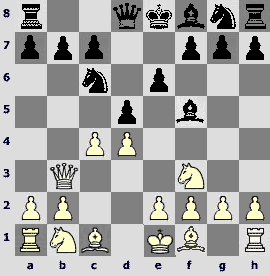
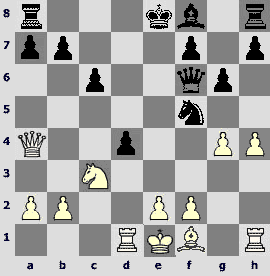
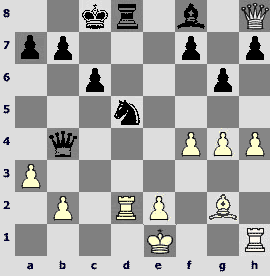

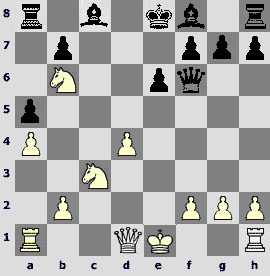
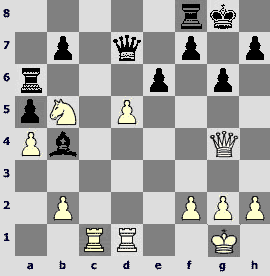
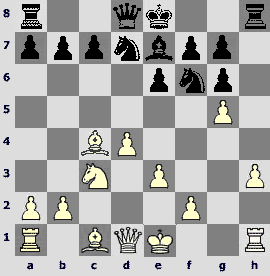
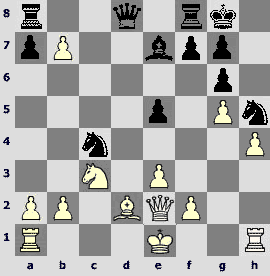

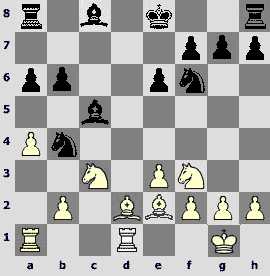

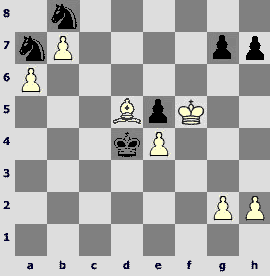
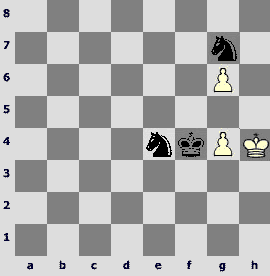
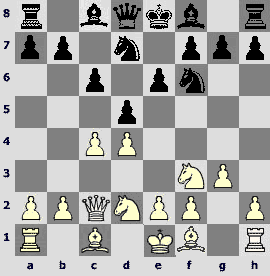
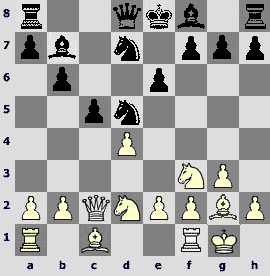


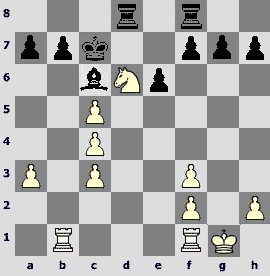
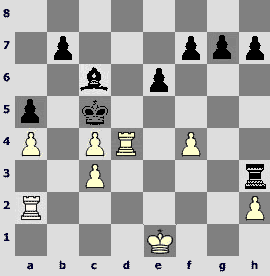
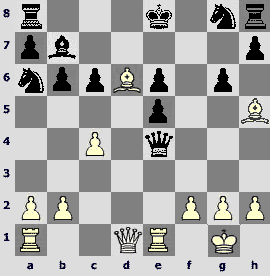
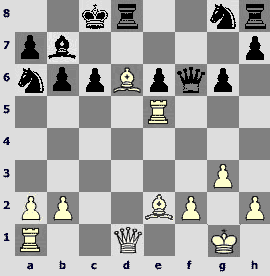

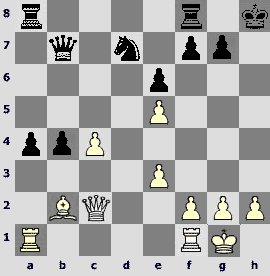
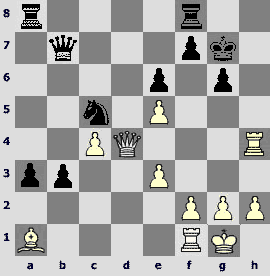
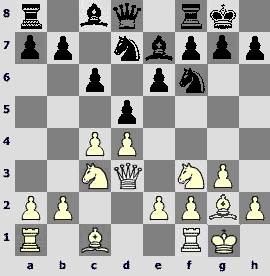
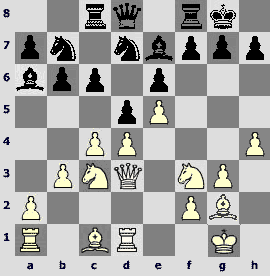

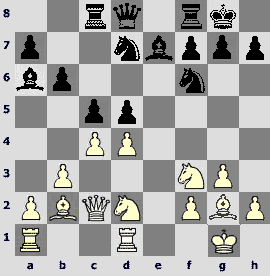
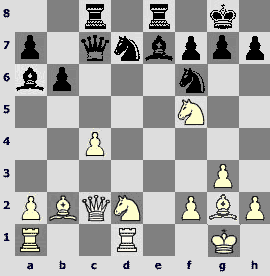
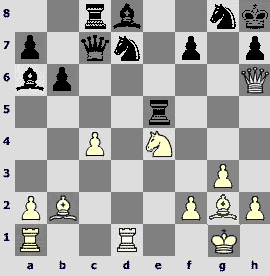
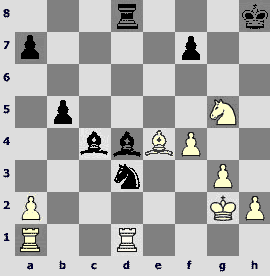

Discuss in forum